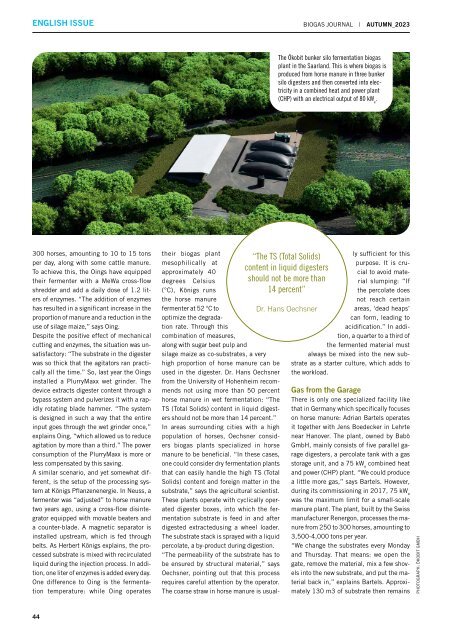Autumn 2023 EN
The German Biogas Association presents its autumn 2023 issue of the English BIOGAS journal.
The German Biogas Association presents its autumn 2023 issue of the English BIOGAS journal.
- No tags were found...
You also want an ePaper? Increase the reach of your titles
YUMPU automatically turns print PDFs into web optimized ePapers that Google loves.
<strong>EN</strong>GLISH ISSUE<br />
BIOGAS JOURNAL | AUTUMN_<strong>2023</strong><br />
The Ökobit bunker silo fermentation biogas<br />
plant in the Saarland. This is where biogas is<br />
produced from horse manure in three bunker<br />
silo digesters and then converted into electricity<br />
in a combined heat and power plant<br />
(CHP) with an electrical output of 80 kW e<br />
.<br />
300 horses, amounting to 10 to 15 tons<br />
per day, along with some cattle manure.<br />
To achieve this, the Oings have equipped<br />
their fermenter with a MeWa cross-flow<br />
shredder and add a daily dose of 1.2 liters<br />
of enzymes. “The addition of enzymes<br />
has resulted in a significant increase in the<br />
proportion of manure and a reduction in the<br />
use of silage maize,” says Oing.<br />
Despite the positive effect of mechanical<br />
cutting and enzymes, the situation was unsatisfactory:<br />
“The substrate in the digester<br />
was so thick that the agitators ran practically<br />
all the time.” So, last year the Oings<br />
installed a PlurryMaxx wet grinder. The<br />
device extracts digester content through a<br />
bypass system and pulverizes it with a rapidly<br />
rotating blade hammer. “The system<br />
is designed in such a way that the entire<br />
input goes through the wet grinder once,”<br />
explains Oing, “which allowed us to reduce<br />
agitation by more than a third.” The power<br />
consumption of the PlurryMaxx is more or<br />
less compensated by this saving.<br />
A similar scenario, and yet somewhat different,<br />
is the setup of the processing system<br />
at Königs Pflanzenenergie. In Neuss, a<br />
fermenter was “adjusted” to horse manure<br />
two years ago, using a cross-flow disintegrator<br />
equipped with movable beaters and<br />
a counter-blade. A magnetic separator is<br />
installed upstream, which is fed through<br />
belts. As Herbert Königs explains, the processed<br />
substrate is mixed with recirculated<br />
liquid during the injection process. In addition,<br />
one liter of enzymes is added every day.<br />
One difference to Oing is the fermentation<br />
temperature: while Oing operates<br />
“The TS (Total Solids)<br />
content in liquid digesters<br />
should not be more than<br />
14 percent”<br />
Dr. Hans Oechsner<br />
their biogas plant<br />
mesophilically at<br />
approximately 40<br />
degrees Celsius<br />
(°C), Königs runs<br />
the horse manure<br />
fermenter at 52 °C to<br />
optimize the degradation<br />
rate. Through this<br />
combination of measures,<br />
along with sugar beet pulp and<br />
silage maize as co-substrates, a very<br />
high proportion of horse manure can be<br />
used in the digester. Dr. Hans Oechsner<br />
from the University of Hohenheim recommends<br />
not using more than 50 percent<br />
horse manure in wet fermentation: “The<br />
TS (Total Solids) content in liquid digesters<br />
should not be more than 14 percent.”<br />
In areas surrounding cities with a high<br />
population of horses, Oechsner considers<br />
biogas plants specialized in horse<br />
manure to be beneficial. “In these cases,<br />
one could consider dry fermentation plants<br />
that can easily handle the high TS (Total<br />
Solids) content and foreign matter in the<br />
substrate,” says the agricultural scientist.<br />
These plants operate with cyclically operated<br />
digester boxes, into which the fermentation<br />
substrate is feed in and after<br />
digested extractedusing a wheel loader.<br />
The substrate stack is sprayed with a liquid<br />
percolate, a by-product during digestion.<br />
“The permeability of the substrate has to<br />
be ensured by structural material,” says<br />
Oechsner, pointing out that this process<br />
requires careful attention by the operator.<br />
The coarse straw in horse manure is usually<br />
sufficient for this<br />
purpose. It is crucial<br />
to avoid material<br />
slumping: “If<br />
the percolate does<br />
not reach certain<br />
areas, ‘dead heaps’<br />
can form, leading to<br />
acidification.” In addition,<br />
a quarter to a third of<br />
the fermented material must<br />
always be mixed into the new substrate<br />
as a starter culture, which adds to<br />
the workload.<br />
Gas from the Garage<br />
There is only one specialized facility like<br />
that in Germany which specifically focuses<br />
on horse manure: Adrian Bartels operates<br />
it together with Jens Boedecker in Lehrte<br />
near Hanover. The plant, owned by Babö<br />
GmbH, mainly consists of five parallel garage<br />
digesters, a percolate tank with a gas<br />
storage unit, and a 75 kW e<br />
combined heat<br />
and power (CHP) plant. “We could produce<br />
a little more gas,” says Bartels. However,<br />
during its commissioning in 2017, 75 kW e<br />
was the maximum limit for a small-scale<br />
manure plant. The plant, built by the Swiss<br />
manufacturer Renergon, processes the manure<br />
from 250 to 300 horses, amounting to<br />
3,500-4,000 tons per year.<br />
“We change the substrates every Monday<br />
and Thursday. That means: we open the<br />
gate, remove the material, mix a few shovels<br />
into the new substrate, and put the material<br />
back in,” explains Bartels. Approximately<br />
130 m3 of substrate then remains<br />
PHOTOGRAPH: ÖKOBIT GMBH<br />
44

















